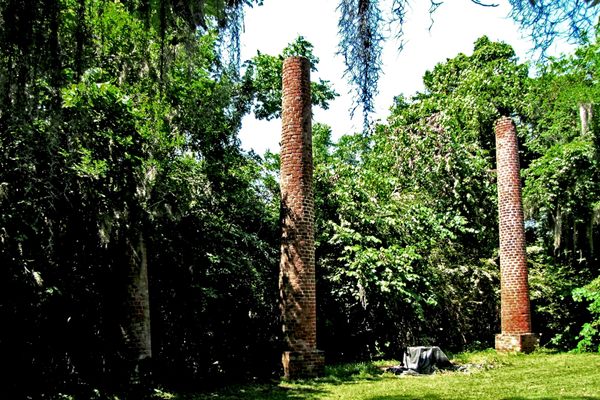Ruins of a Human Zoo at the Forgotten Edge of Paris
Ruins of the Jardin d’Agronomie Tropicale (all photographs by the author)
Colonial exhibitions, showing the exotic plants, animals, and other products of the European empires, were not uncommon in the late 19th and early 20th centuries. Sometimes these went so far as to exhibit actual people from territories in Africa, Asia, and Oceania. The remains of one of these “human zoos” has been quietly left to ruins at the eastern edge of the Bois de Vincennes on the outskirts of Paris.
From May to October of 1907, an estimated two million people attended this exhibition of humanity, purchasing food and refreshments while viewing the temporary communities. People from French colonies including Tunisia, Morocco, Congo, Madagascar, and the Sudan were set up in replica villages like a living curiosity cabinet.
La Réunion Pavilion
The Tunisia Pavilion
The Jardin d’Agronomie Tropicale dates to before the colonial exhibition. It was started in 1899 as a laboratory to test how to better cultivate plants both tropical and non-native for growth in the French empire, such as cacao, coffee, vanilla, and bananas. (Jardin d’Agronomie Tropicale basically means “Garden of Tropical Agriculture.”) Some of these old greenhouses still remain among the small sprawl of what is now a park, open to the public since 2006, but still with its abandoned pavilions and monuments haunting the lush terrain.
All reports I’d read before journeying on the RER to Nogent sure Marne and walking through the quiet residential streets to the Jardin d’Agronomie Tropicale had been of the unsettling isolation of the park, where it seemed no one dared to tread. However, on the morning of my visit there were families with strollers, and several groups of visitors discussing the strange park, as well as some individuals studiously studying the informational placards now installed for each abandoned pavilion. The stately Indochina Pavilion — a colonial exhibition hub for displaying artifacts and products from Laos, Cambodia, and Vietnam — has been restored into a center for the City of Paris to host exhibitions and other programs. The 4.5 hectares of the public park, still sprouting tropical plants and bamboo, are at least no longer a complete secret in the city’s history.
Abandoned greenhouses
Colonial exhibition bridge
That’s not to say it isn’t a spooky space, even in the spring sunshine. It’s one thing to read about human zoos, to research figures like the Khoikhoi Sarah Baartman who died in Paris, her body’s curves a spectacle to the end of her days, and pygmy Ota Benga with his filed teeth living in the Bronx Zoo. It’s quite another to actually walk up to a facsimile of Tunisian architecture and know this is part of the strange environment given as a habitat to people brought far from their homes, often under false promises. (It’s hard to forget the Inuits lured by Robert Peary to New York being promised ”nice warm houses in the sunshine land,” and being left in the basement of the American Museum of Natural History.)
Alongside the old pavilions are war monuments to soldiers from the colonies tucked among the foliage, a reminder of the battles fought not just by the French in these distant lands, but the people they enlisted there to join this foreign cause. There are also relics of countries that were only temporarily carved from Africa in the French Empire, such as a pavilion for Dahomey, a former French colony in West Africa that existed from 1904 to 1958.
Indochina Pavilion
The Dahomey Pavilion
The Jardin d’Agronomie Tropicale wasn’t totally forgotten after the 1907 colonial exhibition. The Guyana Pavilion was later used as an agriculture genetics laboratory by Joseph-Alfred Massibot until he perished in an airplane crash on January 8, 1948 in Algeria. The Tunisia Pavilion became a chemistry laboratory in the 1920s, and then was later used for plant research. There was another colonial exhibition — the 1931 Exposition Coloniale Internationale, also in the Bois de Vincennes — that drew a crowd of 33 million over six months. Some of its statues showing scenes like an African gazing up at a European are now tossed aside in a corner of the Jardin d’Agronomie Tropicale.
Statues from the 1931 colonial exhibition
However, for decades it was totally abandoned, closed behind fences and seen only by trespassers. Its 10-foot-tall red torii gate may now be open to anyone, but this is a place still searching for a purpose. But there is an effort. Last year circus artist Johann Le Guillerm was an artist-in-residence, and the presence of locals shows that it’s at least a draw as a community park. Yet the future of the ruins themselves seems less certain. Perhaps they’ll just be left to linger in shadows of the trees and tropical foliage, an echo of a not-so-distant past of colonialism that remains here and in those communities severed by an empire’s expansion.
Entrance to the Jardin d’Agronomie Tropicale
The Tunisia Pavilion
The Guyana Pavilion
Monument “aux soldats noirs morts pour la France” — “to black soldiers who died for France”
Morocco Pavilion
Morocco Pavilion
Morocco Pavilion
La Réunion Pavilion seen through the bamboo
JARDIN D’AGRONOMIE TROPICALE, Paris, France

















Follow us on Twitter to get the latest on the world's hidden wonders.
Like us on Facebook to get the latest on the world's hidden wonders.
Follow us on Twitter Like us on Facebook